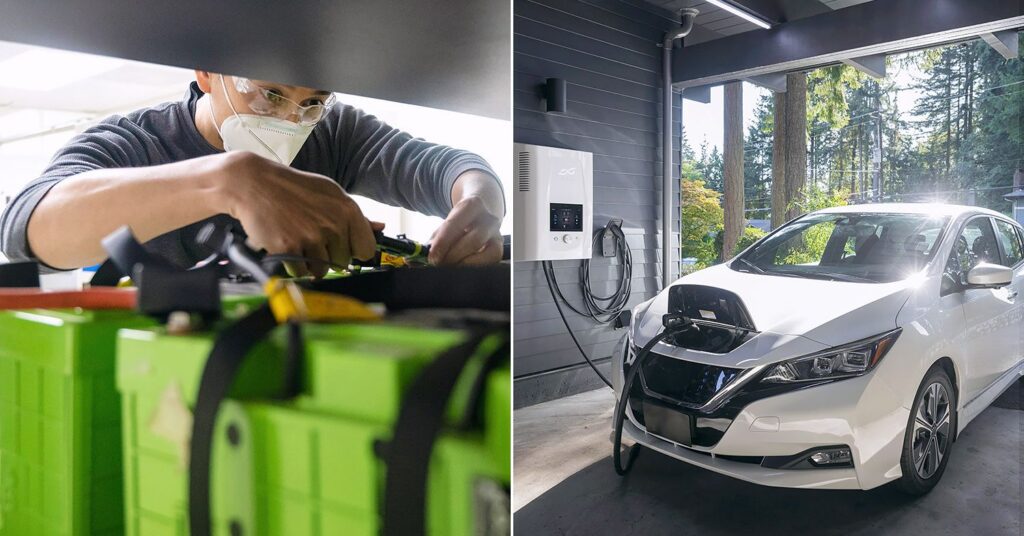Beginning in 2035, all new cars and trucks sold in California must be zero-emission, thanks to a 2020 executive order issued by Governor Newsom. The move was a step forward for the state in reducing climate change-causing fossil fuels. But it’s led scientists scrambling to figure out what to do with all of those old electric vehicle batteries.
Engineers from San Diego State University—led by Chris Mi, distinguished professor and chair at the school’s Department of Electrical and Computer Engineering—may have a solution. They’re currently testing how to give the old batteries a second lease on life storing solar energy on California’s power grid.
“The batteries are no longer good because of degradational power and range,” Mi explains. “But they can still store energy. So we put them in a building and we put energy from the solar into the battery and then the energy can be used when the solar is not generating.”
Putting old EV batteries to good reuse
The lithium-ion batteries used in electric and hybrid vehicles typically have a lifespan of ten years before they must be replaced. An EV battery’s reduced capacity can affect a car’s range in between charges. But, at that point, the batteries still have about 60 to 80 percent of their original capacity.
“Some of them may have enough power and energy capacity to use for an energy storage project,” says Mi. “If you extend their life for another ten years, you can delay the whole life cycle of the battery.”
Once they reach their end of life, batteries are difficult to dispose of. And for an industry that’s making transportation more sustainable, that’s a problem. If the batteries wind up in landfills, they can release harmful toxins into the surrounding environment, including heavy metals. They can also cause fires when exposed to sunlight, similar to cell phone and laptop batteries.
A 2019 study published in the journal Nature found that of the more than one million electric cars sold around the world in 2017, about 250,000 tons of the battery packs went to waste. Thanks to government initiatives, electric vehicles are going to become more accessible—meaning more batteries must be produced.

The potential of second-life battery use
The electric car market is certainly burgeoning. According to the Edison Electric Institute, an association that represents electric companies, 18.7 million EVs will be on the roads by 2030. And that’s just in the US alone. Around the world, there will be about 300 million EVs on roads, accounting for more than 60 percent of all new car sales, according to the International Energy Agency.
Countries around the world have pledged to achieve net-zero carbon emissions by 2050, including Canada, the UK, and Japan. For many, ambitious plans for achieving this also include banning the sale of gas-powered cars. As a result, car manufacturers like Volvo, Ford Europe, and Honda have all announced plans for going all-electric.
While they’re still more sustainable than their gas-guzzling counterparts, electric cars aren’t without their downsides. Some charging points use electricity generated by fossil fuels, requiring a complete transition towards clean energy grids. Their manufacturing process is resource-intensive. In order to make the batteries, rare earth elements like lithium, cobalt, and nickel must be mined.
But more and more, companies are developing battery reusing and recycling technology to counter the increase in lithium-ion battery production. In 2019, approximately 100,000 tons of lithium-ion batteries were recycled globally, according to Circular Energy Storage. Research out of the University of California, Davis finds that recycled materials could provide more than half of the nickel, cobalt, and lithium in new batteries by 2040.
Earlier this year, Redwood Materials Inc. revealed it would be launching an EV battery-recycling program in California, partnering with Ford and Volvo to collect their old batteries. Massachusetts-based Ascend Elements, which works with Honda, has a similar program.
“From an environmental perspective, it would be a good idea to use a second-life battery because they’re not good for e-waste,” explains Mi. “They can be used for second-life applications and we can extend the recycling of those batteries for another ten years. Which is good for the Earth.”
Mi says the process of EV battery reuse for energy storage must still be made economically feasible, since using newly mined lithium-ion phosphate batteries is cheaper. But companies are still taking notice of second-life battery applications, including GM and Nissan.


